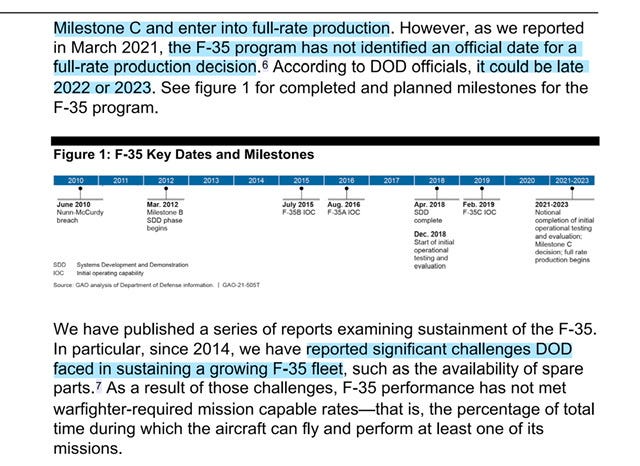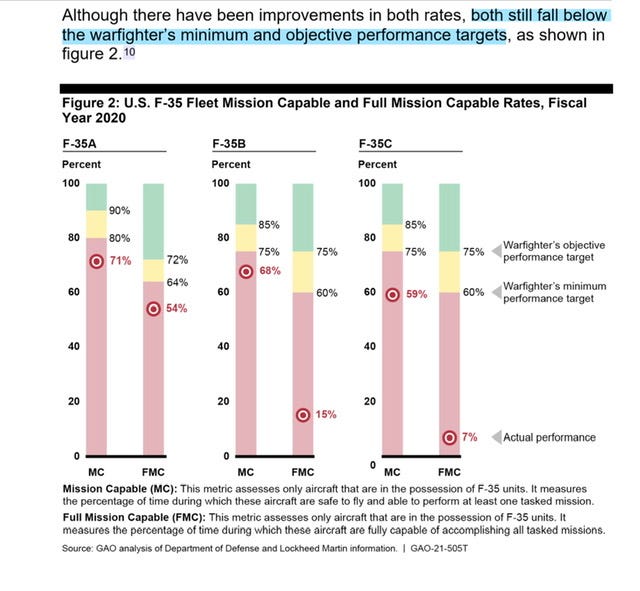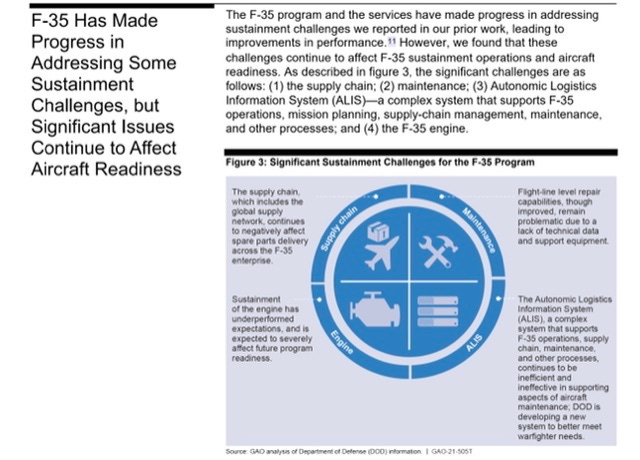The F-35 program -will the DOD embrace the suck? And how much will it cost us?
F-35 SUSTAINMENT - Enhanced Attention to and Oversight of F-35 Affordability Are Needed
by way of background
March 9, 2021 - Lockheed Martin’s Agreement to Pay $70.6 Million for Failures in F-35 Joint Strike Fighter Program, found here
March 20, 2021 - Newly released GAO F-35 Report - F-35 JOINT STRIKE FIGHTER - the DOD Needs to Update Modernization Schedule and Improve Data on Software Development - this money pit just got infinitely deeper, found here
This isn’t personal - this is meant to highlight the ever growing and costly issues surrounding the F-35 Joint Striker Fighter Program and possibly having a more fulsome discussion about the Department of Defense behemoth budget.
the Department of Defense may continue to invest resources in a program it ultimately cannot afford.
At the in-set of Department of Defense (DOD) F-35 program, the DOD stated their F-35 program would include the acquisition of nearly 2,500 F-35 aircraft. With an estimated cost to tax payers of more than $400 billion. But as you know the cost is a longer term investment due to spending an additional $1.27T, as in trillion to operate, sustain and maintenance of the aircrafts. This projected cost has continued to steadily increased since 2012.
The F-35 has become a huge money pit
We testified that the military services collectively face tens of billions of dollars in sustainment costs that they project will be unaffordable. For example, the Air Force needs to reduce estimated annual per-plane costs by $3.7 million (47%) by 2036, or costs in that year alone will be $4.4 billion more than it can afford.
What GAO Found
In layman’s terms, today’s GAO Report details an unsustainable cost both in terms of the production of the F-35 but more importantly the ongoing cost of maintenance, training and parts availability without cannibalizing from other aircrafts.
F-35 mission capable rates—a measure of the readiness of an aircraft fleet—have recently improved, but still fall short of warfighter requirements, as discussed in our draft report. Specifically, from fiscal year 2019 to fiscal year 2020, the U.S. F-35 fleet's average annual;
(1) mission capable rate—the percentage of time during which the aircraft can fly and perform one of its tasked missions—improved from 59 to 69 percent; and
(2) full mission capable rate—the percentage of time during which the aircraft can perform all of its tasked missions—improved from 32 to 39 percent.
Both metrics fall below the services' objectives. For example, in fiscal year 2020 the Air Force F-35A full mission capable rate was 54 percent, versus a 72 percent objective.
Since 2012, F-35 estimated sustainment costs over its 66-year life cycle have increased steadily, from $1.11 trillion to $1.27 trillion, despite efforts to reduce costs. The services face a substantial and growing gap between estimated sustainment costs and affordability constraints—i.e., costs per tail (aircraft) per year that the services project they can afford—totaling about $6 billion in 2036 alone (see fig.). The services will collectively be confronted with tens of billions of dollars in sustainment costs that they project as unaffordable during the program.
Without an assessment of cost-reduction efforts and program requirements (such as number of planned aircraft), along with a plan, the Department of Defense (DOD) may continue to invest resources in a program it ultimately cannot afford. Congress requiring DOD to report on its progress in achieving affordability constraints and making F-35 procurements contingent on DOD’s demonstrated progress would enhance DOD’s accountability for taking the necessary and appropriate actions to afford sustaining the F-35 fleet.
As previously discussed the F-35 program is aggregated in to three parts:
F-35A – A conventional take-off and landing variant that is intended to replace Air Force F-16 fighters and A-10 attack aircraft (and possiblyF-15 fighters). The Air Force plans to procure 1,763 F-35As, making that service the largest customer in the F-35 program.
F-35B – A short take-off and vertical landing variant that is intended to replace Marine Corps AV-8B Harrier vertical/short take-off and landing attack aircraft and Marine Corps F/A-18A/B/C/D strike fighters, which are conventional take-off and landing aircraft. The Marine Corps plans to procure 353 F-35Bs.
F-35C – A carrier-suitable variant that is intended to complement the Navy F/A-18E/F, an aircraft the Navy has been procuring since 1997. The Navy plans to procure 273 F-35Cs. Furthermore, to supplement its own aircraft fleet, the Marine Corps plans to procure 67 F-35Cs.
As with any major (tax payer funded) military investment the program(s) have various milestones in place before the program can enter a new phase - but as it nearly every component of the F-35 program - Milestone C is now delayed to late 2021 into 2022. Wait for it…
Tilts head back and screams W.T.FING.F. This is like a chain reaction in slow motion - where you can see how one (or in this case many) delays can snowball into an avalanche of fiduciary bullshit and nonsensical excuses. This program cost overruns and delays are increasingly problematic and the DOD needs to have a come to Jesus and be “straight” with the American people
Milestone C and enter into full-rate production. However, as we reported in March 2021, the F-35 program has not identified an official date for a full-rate production decision.6 According to DOD officials, it could be late 2022 or 2023. See figure 1 for completed and planned milestones for the F-35 program.1
One of the more troubling findings by the GAO are the growing discrepancies between Pilot “in flight training” and the gigantic chasm as it relates to F-35 maintenance. To be fair it is intellectually dishonest to try and blame the Bush, Obama, Trump or Biden Administration - it’s easy to fall into the trap of “overly politicization” - this is strictly on the DOD and Lockheed Martin and Congress
but as this info-graph shows the delays are having direct impacts on the program’s overall performance and I genuinely have concerns for our highly skilled pilots meaning if their jets are in maintenance that can impact each pilot’s actual flight/exercise training allotment. Which directly impacts the “program readiness”
Although there have been improvements in both rates, both still fall below the warfighter’s minimum and objective performance targets, as shown in figure
With respect to the growing challenges - today’s GAO Report and Congressional Testimony noted:
challenges continue to affect F-35 sustainment operations and aircraft readiness. As described in figure 3, the significant challenges are as follows:
the supply chain;
maintenance;
Autonomic Logistics Information System (ALIS)—a complex system that supports F-35 operations, mission planning, supply-chain management, maintenance, and other processes; and
the F-35 engine


So the point? I’d keep an eye on this program and pay attention to the updates from the DOD - lastly one could ask - at what point will the DOD just say (what those of us who have followed this program for years);
What’s the actual financial cost-benefit to keep throwing money at this troubled program and what will the DOD do to hold the prime contractor accountable?
GAO -F-35 Joint Strike Fighter: DOD Needs to Update Modernization Schedule and Improve Data on Software Development, GAO-21-226 (Washington, D.C.: Mar. 18, 2021).
GAO -F-35 Sustainment: Need for Affordable Strategy, Greater Attention to Risks, and Improved Cost Estimates, GAO-14-778 (Washington, D.C.: Sept. 23, 2014).









Oh man, I retired years ago from the defense sector and we were talking about this money pit program then too.
Meanwhile our cyber defense is languishing. Imagine if the took some of the funding for this and set up robotic factories for building IC’s and semiconductors and continued to expand our rare earth mineral program so we are not entirely reliant on overseas components.
Another factor often discussed is why we export planes to everybody and their brother, cough KSA, if we are paying so much to maintain superiority.
Shittlestix I forgot to include the 2020 House Overnight Hearing concerning this program https://youtu.be/Ptsp-pqu2fs